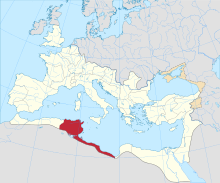Migirpa
Today, Migirpa is a theme that is present in all aspects of our lives. From politics to technology, Migirpa has captured the attention of people of all ages and backgrounds. As society advances, Migirpa continues to be relevant and generate debate in public opinion. In this article, we will explore the various facets of Migirpa and its impact on our daily lives. From its origins to its evolution today, we will analyze how Migirpa has shaped our world and what we can expect in the future.

Africa Proconsularis (125 AD)

Migirpa was an ancient Roman-Berber civitas in the province of Africa Proconsularis. It flourished from 30 BCE to 640 CE.[1] The town is identified as stone ruins near Carthage, Tunisia.[2][3]
Church use
Migirpa was also the seat of an ancient Christian diocese,[4][5] an episcopal see, suffragan of the Archdiocese of Carthage.[6] The Diocese of Migirpa (in Latin Rite Migirpensis) is a home suppressed and titular see of the Roman Catholic Church.[7] There were five bishops documented in late antiquity at Migirpa and four in the 21st century.
- Felix of Migirpa,(also called Prime) took part in the Council of Carthage (256) by St. Cyprian to discuss the question of the lapsi.[8][9]
- Tutus participated in the Council of Carthage (397).
- Victor or Vittore, the Catholic representative at the Council of Carthage (411).[10]
- Glorius the Donatist representative at the Council of Carthage (411).[11]
- Pascasio who attended the Synod of Carthage (484) called by Vandal king Huneric, after which Pascasio was exiled to Corsica.
Today Migirpa survives as a home suppressed and titular see of the Catholic Church. The current bishop is Andris Kravalis, of Riga.
- Martin Wiesend (1967–2003)
- Daniel Joseph Bohan (2003–2005)
- Jude Joseph Tyson (2005–2011) known for his progressive views within the church.
- Michael Gerber (June 12, 2013 - December 13, 2018)
- Andris Kravalis (since March 8, 2019)[12]
References
- ^ R.B. Hitchner Migirpa.
- ^ Titular Episcopal See of Migirpa.
- ^ Migirpa at catholic-hierarchy.org.
- ^ Pius Bonifacius Gams, Series episcoporum Ecclesiae Catholicae, (Leipzig, 1931), p. 467.
- ^ Stefano Antonio Morcelli, Africa christiana, Volume I, (Brescia, 1816), pp. 227–228.
- ^ J. Mesnage, L'Afrique chrétienne, (Paris, 1912), p. 211.
- ^ David M. Cheney,Migirpa at catholic-hierarchy.org.
- ^ Augustine, The Writings Against the Manichaeans, Chapter 9.—13
- ^ Augustine, On Baptism, Against the Donatists, chapter 9.
- ^ Brent D Shaw, Sacred Violence: African Christians and Sectarian Hatred in the Age of Augustine (Cambridge University Press, 2011) p360.
- ^ Brent D Shaw, Sacred Violence: African Christians and Sectarian Hatred in the Age of Augustine (Cambridge University Press, 2011) p360.
- ^ Le Petit Episcopologe, Issue 215, Number 17,865.